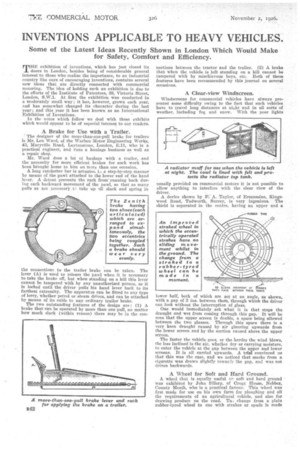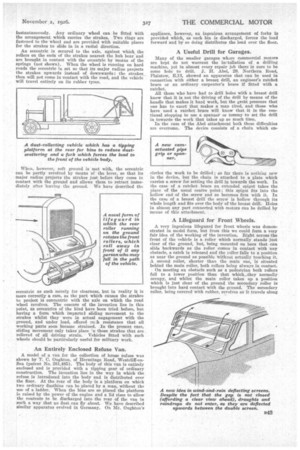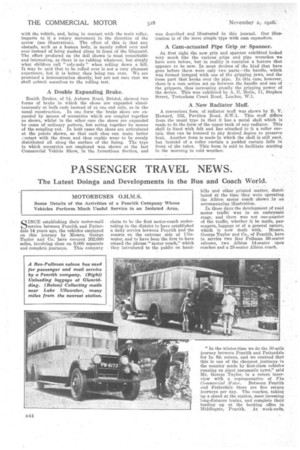INVENTIONS APPLICABLE TO HEAVY VEHICLES.
Page 68

Page 69

Page 70

If you've noticed an error in this article please click here to report it so we can fix it.
Some of the Latest Ideas Recently Shown in London Which Would Make for Safety, Comfort and Efficiency.
THE exhibition of Inventions, which has just closed its doors in London, besides being of considerable general interest to those who realize the importance, to an industrial country like ours of encouraging inventions, contains several new ideas that are directly connected with commercial motoring. The idea of holding such an exhibition is due to the efforts of the Institute of Patentees, 39., Victoria Street, London, SAVA. At first the exhibition was conducted in a moderately small way ; it has, however, grown each year, and has somewhat changed its character during the last year ; and this year it has been known as an International
Exhibition of Inventions.
In the notes which follow we deal with those exhibits which would appear to be of especial interest to our readers.
A Brake for Use with a Trailer.
The designer of the more-than-one-pull brake for trailers is Mr. Len Ward, of the Warben Motor Engineering Works, 43, Maryville Road, Leytonstone, London, E.11, who is a practical engineer, and runs a haulage business as well as a repair shop.
Mr. Ward does a lot of haulage with a trailer, and the necessity for more efficient brakes for such work has been brought home to him on more than one occasion.
A long ratchetter bar is actuateu Li a step-by-step manner by means of the pawl attached to the lower end of the hand lever. A detent prevents the rack from runningback during each backward movement of the pawl, so that as many pulls as are necessary tn take up all slack and spring in
the connections to the trailer brake can be taken. The lever (A) is used to release the pawl when it is necessary to take the brake off, but when standing on a hill this lever cannot be tampered with by any unauthorized person, as it is locked until the driver pulls his hand lever brick to its farthest extremity. The apparatus can be fitted to any type of lorry, whether petrol or steam driven, and can be attached by means of its cable to any ordinary trailer brake.
The two outstanding features of the design are: (1) A brake that can be operated by more than one pull, no matter how much slack (within reason) there may be in the con
nections between the tractor and the trailer. (2) A brake that when the vehicle is left standing on a hill cannot be tampered with by mischievous boys, etc. Both of these features have been recommended by this journal on several occasions.
A Clear-view Windscreen.
Windscreens for commercial vehicles have always presented some difficulty owing to the fact that such vehicles have to travel long distances at night and in all sorts of weather, including fog and snow. With the poor lights
usually provided on commercial motors it is not possible toallow anything to interfere with the clear view of the driver.
A device shown by P. A. Taylor, of Ersanmine, Kingswood Road, Tadworth, Surrey, is very ingenious. The shield is separated in the centre, having an upper and a
g. TAKES PLATE BSTWEEIK THESE POINTS
lower half, both of which are set at an angle, as shown, with a gap of 3 ins, between them, through which the driver can look without the interruption of glass.
One would immediately ask what it is that stops the draught and wet from coming through this gap. It will be seen that the upper screen is double, a space being allowed between the two glasses. Through this space there is a very keen draught caused by air glancing upwards from the lower screen and by the suction caused above the upper screen.
The faster the vehicle goes, or the harder the wind blows, the less inclined is the air, whether dry or carrying moisture, to enter the vehicle at the gap between the upper and lower screens. It is all carried upwards. A trial convinced us that this was the case, and we noticed that smoke from a cigarette was drawn slightly towar;lr the gap, and was not driven backwards.
A Wheel for Soft and Hard Ground.
A wheel that is equally useful or. soft and hard ground was exhibited by John Sillery, of Gregg House, Nobber, County Meath, who is a practical farmer. This wheel was first made for use on his own farm for ploughing and all the requirements of an agricultural vehicle, and also for drawing produce on the road. Tn change from a plain rubber-tyred wheel to one with strakes or spuds is made
Instantaneously. Any ordinary wheel can be fitted with the arrangement which carries the strakes. Two rings are fastened to the wheel and are provided with suitable places for the strakes to slide in in a radial direction.
An eccentric is secured to the axle, against which the rollers on the ends of the strakes nearest the hub bear and are brought in contact with the eccentric by means of the springs (not shown). When the wheel is running on hard roads the eccentric is set so that its major radius projects the strakes upwards instead of downwards; the strakes then will not come in contact with the road, and the vehicle will travel entirely on its rubber tyres.
When, however, soft ground is met with, the eccentric can be partly revolved by means of the lever, so that its major radius projects the strakes just before they come in contact with the ground and allows them to retract immediately after leaving the ground. We have described the
eccentric as such merely for clearness, but in reality it is more correctly a cam, as the part which causes the strakes to project is concentric with the axle on which the road wheel revolves. The essence of the invention lies in this point, as eccentrics of the kind have been tried before, but having a form which imparted sliding movement to the strakes whilst they were in actual engagement with the ground, and under load, offered null resistance that all working parts soon became strained. In the present case, sliding movement only takes place 'n those strakes that are relieved of all driving strain. Vehicles fitted with such wheels should be particularly useful for military work.
An Entirely Enclosed Refuse Van.
A model of a van for the collection of house refuse was shown by T. C. Oughton, of Hermitage Road, Westeliff-onSea (patent No. 281,485). The body of this van is entirely enclosed and is provided with a tipping gear of ordinary construction. The invention lies in the way in which the refuse is introduced into the body and is distributed over the floor. At the rear of the body is a platform on which two ordinary dustbins ran be placed by a man, without the use of a ladder. When the bins are so placed the platform is raised by the power of the engine and a lid rises to allow the contents to be discharged into the rear of the van in such a way that no dust can fly about. We have described similar apparatus evolved in Germany. On Mr. Oughton's appliance, however, an ingenious arrangement of forks is provided which, as each bin is discharged, forces the load forward and by so doing distributes the load over the floor.
A Useful Drill for Garages.
Many of the smaller garages whore commercial motorsare kept do not warrant the in-tallation of a drilling machine, yet in almost every repair job there is sure to be some hole to drill. J. H. Abel, 29, Northern Road, Plaistow, E.13, showed an apparatus that can be used in connection with either a breast drill, an engineer's ratchet brace or an ordinary carpenter's brace if fitted with a ratchet.
All those who have had to drill holes with a breast drill know that it is not the driving of the drill by means of the handle that makes it hard work, but the great pressure that one has to exert that makes a man tired, and those who have used a ratchet brace will know that it is the continual stopping to use a spanner or tommy to set the drill In towards the work that takes up so much time.
In the case of the Abel attachment both these difficulties are overcome. The device Consists of a chain which en circles the work to be drilled; so far there is nothing new in the device, but the chain is attached to a plate which carries a screw for setting the drill in towards the work. In the case of a ratchet brace an extended spigot takes the place of the usual centre point ; this spigot fits into the hollow end of the screw and so becomes firm with it. In the case of a breast drill the screw is hollow through its whole length and fits over the body of the breast drill. Holes in almost any part connected with motors can be drilled by means of this attachment.
A Lifeguard for Front Wheels.
A very ingenious lifeguard for front wheels was demonstrated in model form, but from this we could form a very fair idea of the working of the invention. Right across the front of the vehicle is a roller which normally stands just clear of the ground, but, being mounted on bars that can slide backwards as the roller comes in contact with any obstacle, a catch is released and the roller falls to a position as near the ground as possible without actually touching it. A second roller, shorter than the main one, hi situated behind the main roller, both rollers being always in contact.
On meeting an obstacle such as a pedestrian both rollers fall to a lower position than that which—they normally occupy, and whilst the main roller takes up a position which is just clear of the ground the secondary roller is brought into hard contact with the ground. The secondary roller, being covered With rubber, revolves as it travels along
with the vehicle, and, being in contact with the main roller, imparts to it a rotary movement in the direction of the arrow (see illustration). The effect of this is that any obstacle, such as a human body, is merely rolled over and over instead of being pushed along in front of the lifeguard. The effect produced on the doll shown is most remarkable and interesting, as there is no rubbing whatever, but simply what children call " roly-poly" when rolling down a hill. It may be said that to be rolled over is not a very pleasant experience, but it is • better than being run over. We are promised a demonstration shortly, but are" not sure that we shall submit ourselves to the rolling test.
A Double Expanding Brake.
Zenith Brakes, of 14, Auburn Road, Bristol, showed two forms of brake in which the shoes are expanded simultaneously at both ends instead of at one end only, as in the usual construction. In one formthe. brake shoes are expanded by means of eccentrics which are coupled together as shown, whilst in the other case the shoes are expanded by cams of ordinary pattern, but acting together by means of the coupling rod. In both cases the shoes are articulated at the points shown, so that each shoe can make better zontact with the drum, and thus enable wear to be evenly distributed all along the surface of the lining. The type in which eccentrics are employed was shown at the last Commercial Vehicle Show, in the Inventions Section, and
was described and illustrated in this journal. Our illustration is of the more simple type with cam expenders.
A Cam-actuated Pipe Grip or Spanner.
At first sight the new grip and spanner exhibited looked very much like the various grips and pipe wrenches we have seen before, but in reality it contains a feature that appears to be new. In most devices of the kind that have gone before there were only two parts—the handle, which was formed integral with one of the gripping jaws, and the loose part that hooks over the pipe. In this case, however, there is a cam action set up between the handle and one of the grippers, thus increasing greatly the gripping power of the device. This was exhibited by A. B. Mode, 11, Stephen Street, Tottenham Court Road, London; W.1.
A New Radiator Muff.
A convenient fora of radiator muff was shown by R. V. Howard, 152, Pavilion Road, S.W.1. This muff differs from the usual type in that it has a metal shell which is made to fit the form of the upper tank of any radiator. This shell is lined with felt and has attached to it a roller curtain that can be lowered to any desired degree to preserve heat. Another form is made in which the shell is still used, but instead of a roller curtain a padded curtain falls in front of the tubes. This form is said to facilitate starting in the morning in cold weather.




























































































































